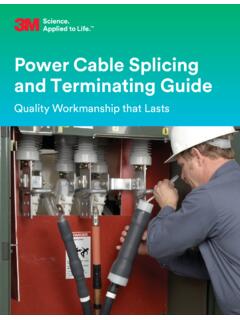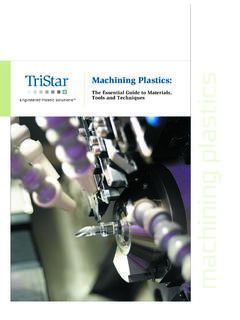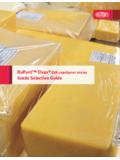Transcription of DESIGN GUIDE - Thermoform
1 DESIGN GUIDEOVERVIEWDRAW RATIORADII AND CHAMFERSUNDERCUTSDRAFTTEXTURESRIBS & LOUVERSFASTENINGDIMENSIONAL TOLERANCESDIMENSIONING65 Waukegan Road | Lake Bluff, IL 60044 | PH: | Waukegan Road | Lake Bluff, IL 60044 | PH: | PROCESSESVACUUM FORMING:The process of evacuating air from the sealed space between the hot sheet and the mold, thus allowing atmospheric pressure ( ) to force the sheet to conform with the contour of the : Non-critical appearance covers, dunnage trays, internal covers. Competes with sheet metal and Fiberglass. A low to medium volume FORMINGThe process of applying compressed air (20-120 ) to a hot sheet, thus forcing it to conform to the contour of the mold. vacuation of the air between the sheet and the mold is : High appearance covers, computer housing, microprocessor based equipment, typically non-structural. Part size is usually 12 x 12 and larger. Competes with injection molding. A low to medium volume process. TWIN-SHEET PRESSURE FORMINGThe process of injecting compressed air (20-120 ) between two hot sheets, thus forcing it to conform to the contour of each of two molds mounted opposed to each other.
2 Evacuation of the air between the sheet and the mold is : Those enclosures that require structural rigidity. Appearance items that require high surface detail and yet light weight. Competes with blow molding and rotational molding. A low to medium volume THE SHEETT hermoforming requires a previously extruded sheet. In the process the two operations; , sheet extrusion and forming, are uncoupled. This simplifies the process, but does add to the cost. Costs are increased because of the extra energy required to heat the polymer twice, and the fact the extruders are commonly custom processors that also need to generate profits to continue to exist. On the other hand, gauge changes, color changes, even material ( , polymer) changes can be done very easily in thermoforming because neither the oven nor the mold care what the sheet looks Waukegan Road | Lake Bluff, IL 60044 | PH: | the final part almost always weighs less than the starting sheet, the trim must be captured and returned to the sheet extruder for reprocessing.
3 This results in a scrap credit which is included in the price of every SELECTIONA lmost any thermoplastic can be thermoformed. As with any manufacturing process, there are wide variances in the cost of different materials due to the polymer cost, temperature of processing, crystalinity of the resin, or, in general, the degree of difficulty of extruding the sheet. The most common resins (and therefore the most cost effective ones to specify) are FRABS, ABS, DKE or Kydex, HIPS, HDPE or RATIOGUIDELINES:The deeper or taller the part the heavier the starting gauge of sheet required. Allowing the part or any feature of the part to be narrower than it is tall will thin the sheet at a much quicker :The draw ratio is the key to understanding thermoforming processes. The part has a finite amount of surface area that needs to be covered by a flat two-dimensional sheet. When the sheet is heated and forced over or into a mold it must stretch to conform to that shape. As the sheet stretches it thins out.
4 Local DESIGN features on the part may cause the sheet to thin at a greater rate than in adjacent :The draw ratio can be described numerically if the surface area can be calculated. The formula for expressing the draw ratio is as follows:Draw Ratio = the Surface Area of the part / Footprint of the part65 Waukegan Road | Lake Bluff, IL 60044 | PH: | #1:Assume a part is 10 x 12 x 2 deep. Therefore the Draw Ratio will be:Surface Area = 2(10 x 2 ) + 2(12 x2 ) + 10 x 12 = 40 + 48 + 120 = 208 Footprint = 10 x 12 = 120 Draw Ratio = 208 /120 = the desired ending wall thickness of the part is use the draw ratio as follows to estimate the starting gauge of the sheet:Draw Ratio x Desired Finished Gauge = Minimum Starting x = .170 Assuming perfect material #2:Assume a part size of 10 x 11 x 5 Area = 2(10 x 5 ) + 2(11 x 5 ) + (10 x 11 ) = 300 Footprint = 10 x 11 = 110 Draw Ratio = the desired ending wall thickness is use the draw ratio value as x =.
5 273 starting gauge. Assuming perfect material above examples ignore the effect that a specific feature on the part ( a localized severe draw like a sharp corner) may have on the thinning of the sheet. The draw ratio is designed to get the part designer in the ball park 65 Waukegan Road | Lake Bluff, IL 60044 | PH: | calculating the necessary starting gauge. Many part quotations will have two gauges specified (a high and low) because of the difficulty in predicting the proper starting gauge. Because the starting gauge is so critical to the cost of the part it is important to get proper feedback from the thermoformer when reviewing draw ratio. There are many thermoforming techniques and mold designs used to help the sheet stretch as uniformly as possible. A competent thermoformer will be able to implement them in a project with a difficult draw AND CHAMFERSGUIDELINES:Avoid a sharp three-sided corner by using a radius or chamfer. The radius at the bottom of the draw is most critical.
6 The deeper the part the larger the radius or chamfer :The key to good part DESIGN in thermoforming is understanding the need for a proper size radius or chamfer. These features are typically needed to allow for part strength, retention of material thickness, and/or :One of the most difficult features in thermoforming is the three-sided sharp corner in a female mold. This feature accentuates the draw ratio because it forces the material to over the three walls as it is pushed into the corner. The material appears to stretch and thin out at a geometric rate, usually causing the material to either thin to an unacceptable ending gauge or actually tear and create a hole in the part. A quick check to see if this condition is occurring is to hold a part up to a light source and inspect the corners to see if the gauge is so thin that light can be transmitted through the part. Many times the tool is constructed ignoring this problem, causing either a heavier starting gauge to be used or an adhesive filler applied to the inside of the part backing up the corner and adding strength.
7 These cures will add significant cost to the part and should be avoided if at all common DESIGN technique is to use radii and/or a chamfers on the part, 65 Waukegan Road | Lake Bluff, IL 60044 | PH: | the material from having to continue deeper into the corner, thus arresting the thinning hat would normally occur. The other advantage of radii and chamfers is that they distribute stress over a larger area than a sharp 90 degree corner. A chamfer does not distribute the stress as well as a radius, but it gives the designer the option of sharp corners at the transition points of the chamfer. Where a three-sided corner does occur, one large radius with a chamfer or smaller radius on the other edges is often sufficient to solve the thinning and strength problems that the draw ratio gets larger the radii will almost always have to be increased. Use this chart as a very rough rule of thumb to help determine the approximate radius you may need:Depth of Part Radius0 - 3.
8 015 - .125 3 - 6 .125 - .250 6 - 12 .250 - ?Sometimes it may be necessary to prototype a particular corner or feature of the part prior to the start of mold construction. This is usually a quick method of answering any questions regarding material thickness :Keep the distance that the undercut projects into the part to a minimum. Typical undercut sizes are .375 with some localized tabs of up to 1 . Because the undercut will require even more stretching of the sheet stock it is important to keep the draw ratio in mind when designing for :Undercuts are a feature that can be added to thermoformed parts very cost effectively. Undercuts offer increased part strength, a locating edge, a fastening point, and/or the ability to hide a trimmed edge. Tooling costs will be increased, but not nearly the amount it would be if it were an injection molding or structural foam molding Waukegan Road | Lake Bluff, IL 60044 | PH: | most undercuts are an inward facing flange. However, other types of undercuts might include a reverse drafted wall, a molded in countersink or a DESIGN line that is not parallel to the direction of pull out of the mold.
9 Because these features increase the surface area of the part they increase the draw ratio of the part. One of the most common requests is to carry an undercut flange into one or all four corners of a part. The problem this presents is that it causes the material to stretch even more in an area that is typically the thinnest on the part, if it is a female tool. By stepping the undercut back in the corners you allow for better material undercuts do not require the mold to be collapsible or removable. The undercut may be small enough or the material flexible enough to allow the part to strip out of the mold. This is more likely to occur on a female mold because the part will shrink away from the sidewalls of the tool, as opposed to a male mold which finds the material shrinking tighter around the undercut requires a moving section in the mold you must allow for a parting or witness line on the part. This is not normally a problem on an undercut, which is an inward facing flange, since the parting line can be hidden at the point at which the part turns in.
10 But on other undercuts there needs to be an allowance for the parting line. Many times the parting line is used as a point of demarcation between a textured and untextured safest way to incorporate an undercut in the mold is with an articulating section. In the past removable loose pieces have been used and placed back in the mold once they were freed from the part prior to the next shot. Because of the risk of tool damage due to improper alignment or the marring of a textured surface, the best long term approach is to incorporate the articulation of the undercut section with the controls of the forming machine operating it automatically. A quality thermoformer will have this :For parts that are formed into a female mold with a texture allow one degree of draft for every thousandth of an inch of texture depth. With parts formed over a male mold allow three degrees of draft as a Waukegan Road | Lake Bluff, IL 60044 | PH: | need for draft is driven by the coefficient of thermal expansion of the plastic.





